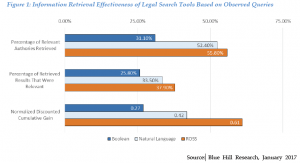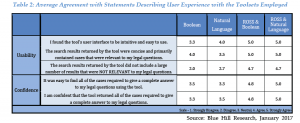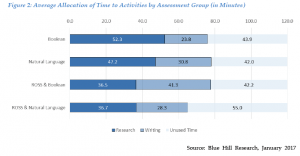(A) Information retrieval accuracy
The criteria were percentage of relevant authorities retrieved (0—100%), percentage of retrieved results that were relevant (0—100%), and a measurement of how closely the prioritization of results matched the ideal using the standard scale for this, called the “Normalized Discounted Cumulative Gain,” or NDCG to you (0.0—1.0, by convention).
Boolean (in dark blue) brings up the rear here, across the board. It’s the least thorough, the least relevant, and most poorly ranked. Less than one in three of the responsive authorities was retrieved, barely one in four was relevant, and natural language and ROSS NDCG scores were 46% and 128% higher, respectively. Natural language (light bluish-grey) was second across the board, and ROSS (orange) won handily: It produced more relevant results with less noise and concentrated them highly within the first results the user sees.
(B) User satisfaction, shall we?
Less legible at reduced magnification, but here are the highlights.
Researchers were asked to score their agrement/disagreement with each subjective experience question using the familiar 5-point “Likert” scale, where 1 = strong disagreement and 5 = strong agreement. Again, across the board, ROSS won with user’s satisfaction and confidence, by one full point or more. Indeed, ROSS scored a perfect 5.0 on every measure but one (“results did not include a large number that weren’t relevant”) where ROSS scored 4.7 but Boolean scored 2.0 and natural language 2.7.
Anecdotally, Blue Hill notes that participants in the ROSS group used ROSS more and more as they progressed through the questions, confirming satisfaction and confidence.
(C) Efficiency
The two-hour limit proved no obstacle, but research took 30% less time with ROSS than with Boolean and 22% less than with natural language (36 1/2 minutes vs. 52 and 47). Although Blue Hill also measured writing time, because it varied greatly among assessment groups and among individuals, they concluded that no “discernable pattern” emerged, so drew no conclusions on that score. But here is the efficiency chart:
There’s no question research with ROSS is more efficient: Only you can answer whether that’s good or bad (just don’t ask your clients which they prefer; you might not get the answer you want).
Our Blue Hill friends are king, and thorough, enough to present an entire table quantifying the potential time savings—and revenue in billable time made available by completing the research faster—should you care to examine it at home. It assumes greater efficiency reduces writeoffs, so the time saved is truly available for incremental billing and collecting. If you disagree, they politely display the marginal revenue at 10%, 25%, 33.3%, 50%, 75%, and 100% conversion ratios.
I will cite only the most conservative number they provide, which goes to the ROI of investing in AI.
Assuming:
- A cost per AI-enabled seat of $2,400 to $4,800 per year;
- A 22% (natural language) or 30% (Boolean) time savings by using ROSS, and
- A billing rate of $320/hour
Then:
- The return (marginal revenue – cost of AI) ranges from $506/year to $3,787/year at a 10% conversion rate of time saved, for an ROI of 10.5—158%.
- At a conversion rate of 100%, the ROI spikes to 1,005%—2,478%.
As I said, I’ll let you run the numbers at home.
Our assumption until now has been that it’s early days for AI and so we could ignore it. We were half right. It’s still very early days for AI. Think you can still ignore it?
If after all this you don’t even want to take a closer look, I have a question: Are you still writing by candlelight or have you advanced to gas lamps? Because you’re surely not interested in electricity.







A reader who prefers anonymity (but who knows to a fare-thee-well whereof he speaks) wrote me as follows, verbatim:
I would be most interested in other knowledgeable comments.